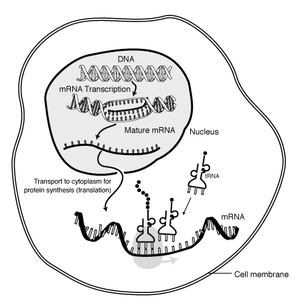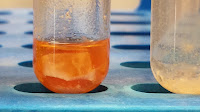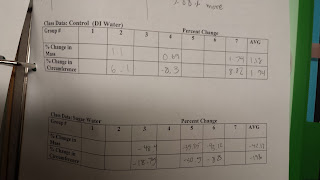In this unit, we learned about walking the dogma - the basics of protein synthesis, the process in which DNA becomes a protein. We did multiple labs that helped us understand the essentials of this unit, including DNA structure and function, DNA replication, and Gene expression and regulation.
Protein synthesis has many steps. First, a copy of the DNA (deoxyribonucleic acid) is made in a process called transcription, then the copy is used to make a protein, in translation. Proteins are essential to life. The first step of translation is for a section of DNA, known as a gene, to be copied by an enzyme, in the nucleus. The copy is called messenger RNA, often abbreviated as mRNA. RNA has a few main differences form DNA: It is only single stranded, and the base uracil replaces thymine.
After the copy is made, the mRNA leaves the nucleus and travels to the cytoplasm. Then, translation beings - the mRNA bonds with a ribosome, which will make a protein. The ribosome reads the first three bases called a codon, and determines which amino acid corresponds with that sequence. Each amino acid that is determined by the codon is read by the ribosome. Amino acids are bonded together and when the mRNA is done being translated, the amino acid chain fold up to become a protein.
The gene expression and regulation lesson was particularly hard for me, but it was the one that I found the most interesting. The basic questions of that unit was: Why do genes appear in the correct places and at the correct times? Why don't we have eyes on our feet and toes on ours heads? And the answer was gene expression and regulation.
Gene expression is the process of a gene being used to produce a gene product of the phenotype, basically what gene is expressed in the person. Gene regulation is a mechanism used by cells to increase or decrease the expression of a certain gene.
Another essential concept in this unit was Mutations. Although the connotation of the word mutation notes otherwise, mutations are generally very small and can have little to no effect. Is biology a mutation is a change in the DNA code. Mutations are happening almost constantly in our body. There are two main types of mutations - substitution and frameshift mutations. Substitution is when one nucleotide is substituted for another. There are two types of frameshift mutations - insertion and deletion. Insertion is when an extra base is put in and deletion is when a base is taken out.
The effect of the mutation is truly determined by where the mutation is placed. Suppose a harmful mutation to create a STOP amino acid, is placed at the front of the amino acid sequence - then the harms would be devastating. But, if the same mutation is placed near the end, then the amino acid sequence is still changed, but on a much smaller scale, thus it would not be that harmful.
One of my strengths in this unit were the labs - They really helped em visualize and understand the processes. We did a DNA extraction lab as well as a protein synthesis lab, among other things. These labs allowed me to get a full understanding of the concepts. The process of doing the lab, whether the product came out good or not, helps me understand concepts much better than reading or watching a vodcast.
One of my weaknesses in this unit were the vodcasts. Some of the vodcasts were hard to fully understand, but I was able to ask questions to my group and do the labs to make up for it. The vodcasts were especially hard because diagrams were confusing. I was not able to follow some of the diagrams, but when we did them on the board in class, I got the concepts.
Overall my growth as a learner in this unit has become tremendous, mainly because of a VARK questionnaire that I took at the end of my last unit. It told me that I was a better visual learner, and I have always known that I always understanding best when actually doing something. I feel that I have really learned what helps me understand certain concepts and how I should study in the future for science, or for any other subject. This will help me throughout my years of learning, especially as finals week comes nearer.
This unit has also taught me about how to react well to setbacks. During the DNA extraction lab, at first, I was not able to extract DNA properly, due to a mistake in our procedure. But instead of getting mad at myself, I kept my head held high and redid the lab in the correct way. I was able to finish the lab before class ended and thus, I learned how to recover form a small setback in a lab.
This unit also really helped me learn how to collaborate with others in my group. During most of my previous units I understood most of the vodcasts and there was no need, really, to discuss properly with my group about it. But in this unit, since I did not understand the vodcasts completely, I needed to collobarate with my group to make sure I got the concepts down.
This unit has also taught me about how to react well to setbacks. During the DNA extraction lab, at first, I was not able to extract DNA properly, due to a mistake in our procedure. But instead of getting mad at myself, I kept my head held high and redid the lab in the correct way. I was able to finish the lab before class ended and thus, I learned how to recover form a small setback in a lab.
This unit also really helped me learn how to collaborate with others in my group. During most of my previous units I understood most of the vodcasts and there was no need, really, to discuss properly with my group about it. But in this unit, since I did not understand the vodcasts completely, I needed to collobarate with my group to make sure I got the concepts down.































